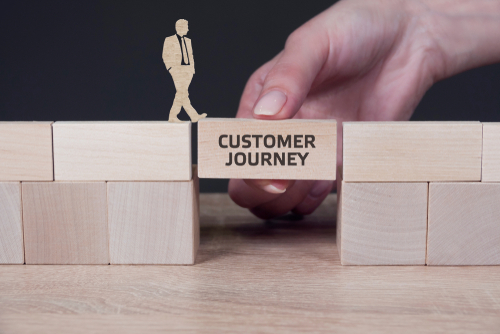
In today’s economy, businesses of all sizes face the same challenges. How do you grow a business in an increasingly noisy and competitive landscape, while acquiring new users and retaining existing ones? For the savviest companies, whether they’re B2B SaaS or B2C, successful marketing comes down to understanding how to leverage the buyer journey. By optimizing each step of the customer’s purchase journey, businesses can maximize ROI in their marketing efforts while delighting customers along the way.
Breaking Down the Buyer Journey
The buyer journey consists of five distinct phases: awareness, consideration, conversion, loyalty and advocacy. Each phase offers unique opportunities for marketers to capture customers’ attention and turn them into long-term fans of the brand. Let’s look at the key elements of each stage in more detail.
- Awareness – During this stage of the customer journey, potential buyers begin to become aware of your product or service offering and start researching solutions that meet their needs.
- Consideration – At this stage, customers have identified a problem they need to solve and are now looking for specific solutions and weighing up different options available on the market.
- Conversion – This critical stage is where marketers need to create a frictionless user experience that will enable people to effortlessly purchase products or services with little effort or time required on their part.
- Loyalty – After someone makes a purchase from your business, it’s important to nurture them into becoming loyal customers who keep coming back for more. Additionally, it’s wise during this phase to stay proactive with feedback collection from customers in order to identify areas needing improvement within your product offering or brand experience overall.
- Advocacy – The final step in the customer journey has tremendous value for businesses. These powerful ambassadors have already had positive experiences with your brand and are more likely to recommend you over competitors when talking with friends and family, thus driving more organic growth your way. Win-win.
Best Practices for Buyer Journeys
Now that we’ve walked the complete lifecycle of the buyer journey, let’s dive into key tactics and best practices for making the most of each of them. Think about your approach by taking into account the type of messaging you plan to take to market and the mediums in which you plan to engage and acquire users. Not every message or piece of content is suitable for each lifecycle stage. To help you get the most out of each of them, we’ve broken out some best practices and key tactics.
- Awareness – Effective strategies during this stage include traditional content marketing assets like blogs and articles, as well as paid media advertising on search engines and social media platforms.
- Consideration – Informative product comparisons, case studies, and customer testimonials help train focus on educating potential buyers about why your product is better than other competitors.
- Conversion – Removing friction is the name of the game. Providing discounts or free shipping can be helpful here as well as eliminating any unnecessary steps throughout the checkout process like extra forms or phone calls.
- Loyalty – Businesses can increase repeat purchases through personalized touchpoints such as exclusive offers and rewards programs. At this stage, be sure to get feedback from customers to measure NPS and source suggestions for product features. Building a community around your product or niche can help you create a stage where customers and prospects share the problems they are trying to solve and the features that would deliver them the most value.
- Advocacy – Strategies like referral programs to incentivize people to engage long past their initial purchase, further increasing ROI in a given company’s customer acquisition efforts.
Optimize Buyer Journeys in Real Time
Launching and building a buyer journey is just the tip of the spear. The best way to get the most mileage out of your strategy is to continue to iterate, test, and analyze the results to inform future optimizations in your go-to-market strategy.
Every step of the customer journey can leverage to help you meet your business goals, and it’s important to map your marketing efforts to each lifecycle stage to ensure you’re getting the most out of your team and resources. By strategically ensuring each step in the buyer journey is driving business value and creating exceptional experiences personalized to each user, businesses can significantly grow their sales with minimal costs associated.
Get our newsletter and digital focus reports

Stay current on learning and development trends, best practices, research, new products and technologies, case studies and much more.



